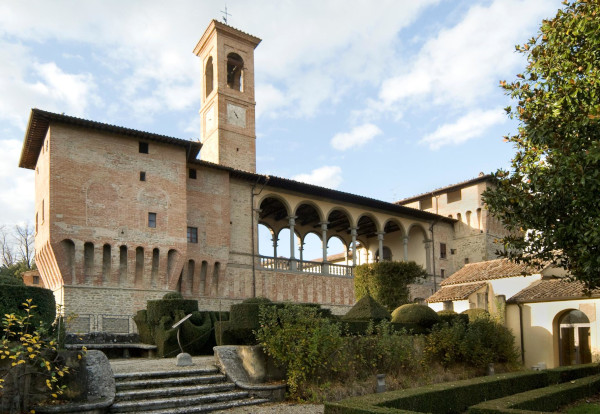


Bufalini Castle was built as a little fortress of the Ghibelline family of the Dotti of Sansepolcro. After the battle of Anghiari in 1440, the military fortification became a military outpost to defend the territory of Città di Castello and was destroyed at the end of the 15th century by order of the Florentine Republic.

Owned in 1487 by Niccolò of Manno Bufalini, it was rebuilt on the project of Roman architect Mariano Savelli and on the instructions of Giovanni and Camillo Vitelli,warlords and experts in military architecture. It assumed the appearance of a fortress, with an irregular square plan with four towers at the corners, one of which is the largest tower. A large ditch with water surrounded it. The history of the building is indissolubly tied to that of the Bufalini family, boasting characters renowned in ecclesiastical, literary and legal fields. From the thirties of the sixteenth century, the fortress was transformed into a noble residence meeting specific artistic, social and cultural needs, according to the will of Giulio I and his brother, Abbot Ventura Bufalini.

Though the interior has undergone major changes, with the creation of large rooms spread around a courtyard with two withside porches, it dates back to that time the inserting the loggia into the façade and the monumental entrance into the central position. From the outside, the original military structure of the building was clearly visible. The project of the palace was the work of Giovanni di Alessio ,a florentine architect of the circle of Sangallo, called Nanni Unghero, but the work was completed by Vignola around 1560.

During the last decade of the 17th century and the early 18th century, the palace was transformed according to the project of Giovanni Ventura Borghesi, architect and painter of Città di Castello, in a charming country villa with italian garden. The building was enriched in the 18th century with fine works of late-baroque style art, including paintings and frescoes on fresco and canvas, also designed to celebrate the Bufalini become marquis. In July 1989, Bufalini Castle was acquired by the State, a rare example of an almost complete historical manor house that retains much of its furnishing from the XVI to the XIX century with a collection of paintings from the Bufalini Palace of Città di Castello.

Currently the whole complex is set up, painted, furnished, tapestries, tiles and various busts of Roman times, according to the taste of the noble residence. In the tour you can admire: the room of pagan divinities and the Prometheus room with frescoes by Cristofano Gherardi, the loggiato, the room of the sideboard, with the windows that preserve the precious ceramic tableware and glassware, the dining room, the living room: the room of the throne with canvases representing scenes from the Old Testament and the Ariosto's furious Orlando; the portrait gallery; the stucco room; the room of Giovanni Ottavio Bufalini, with the beautiful cradle.

The garden is a typical example of an Italian garden, which today is in its shape of the 18th century. The rose garden, the so-called "paradise" and the labyrinth, are particularly attractive for this beauty.
Bufalini Castle
Address: San Giustino via Largo Crociani, 3
Phone: +39 075 856115
Site:
http://www.castellobufalini.beniculturali.it/Location inserted by
Lorenzo Renzulli